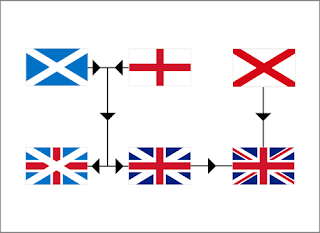The Union Jack
The Union Jack of the United Kingdom was born in 1606 with a decree from King James I. He was the King of Scotland, and of England at the same time, and “his” ships where having confusing problems as to which flag to fly. The St George Cross, or the St Andrews Saltire. By decree, the initial form of the Union Flag was born. With the St George Cross superimposed over the St Andrews flag of Scotland. Unofficially, in Scotland, they flew a Scottish variation. This had the white cross of the Scottish flag over the red cross of the English flag.
However, on the execution of James, the flag fell out of favour, with many people simply opting to go back to their original flags. However, It was the 1707 Act of Union that finally unified Scotland and England into the “United Kingdom of Great Britain” that saw a unified flag emerge. This being the St George Cross imposed over the St Andrews Cross of Scotland. And this time, it was not just flown at sea, but also adopted for use on land as well.
There is one fact to note, the red Cross of St George does not actually “touch” the blue of the flag of Scotland, as it is fimbriated or bordered by white to follow the rules of tincture which prevent “colours of tincture” from coming into contact with each other.
Wales and Ireland had no look-in with the flag. Wales had been annexed by King Edward of England in 1282, and politically had been merged with England so did not legally exist. Also, Ireland was in a political union with England, not Scotland. However, it was common to find the Irish shield imposed over the centre of the flag.
The flag finally took on the look it is famed for today with the passing of the 1801 Act of Union that merged the Kingdoms of Great Britain and Ireland. This gave us “The United Kingdom of Great Britain and Ireland.” A sign of this union was the addition of the Cross of St Patrick. Though it is unclear that the cross can genuinely be linked with St Patrick. It is commonly held that the cross was actually taken from the arms of the FitzGerald family, a very powerful family in Ireland.
The cross of St Patrick was placed off-centre over the cross of St Andrew. This was to prevent domination. Also, the cross of St Patrick is fimbriated. That is, no red is touching blue. Though, in the 1920’s with the birth of the Irish Free State, the fear was that the flag would have to lose the red cross of St Patrick. However, it was all resolved when Northern Ireland opted to remain within the United Kingdom, allowing the Irish cross to remain in the flag.
The setting of the Cross of St Patrick" does mean that there is a "correct" way up to hang the flag. The way to see if the flag is the right way up, is take a look at the upper hoist canton (top left corner) if the Scottish saltire has dominance, then its the right way up. In other words, the broad part of the white diagonal is above the red diagonal of the Irish cross.
The incorrect way, and correct way to hang the Union Jack
This does cause problems, as the flag does seem to have a high degree of symmetry in it, and it is not obvious if it is hung incorrectly. With some flags, such as the US flag, it is easy to see if it is upside down. It is not so easy with the Union Jack. It is quite common to see the Union Jack upside down in parks around the world that fly foreign flags.
It has also been an embarrassment for the UK government, with the signing of an agreement with China being done in Downing Street, with a Chinese flag, and reversed Union Jack!
It is worth noting that the Union Jack is officially called the Union Flag. The Jack actually comes from Naval use, the Jack being. the flag at the front of the ship. However, the name "Union Jack" has entered into common parlance, and is effectively the unofficial name of the flag.
This current form of the flag is in use around the world. Not is it just the flag of The United Kingdom of Great Britain and Northern Ireland, but it is also in use as part of flags of many nations and states around the world. Such as Australia, New Zealand, Tuvalu and Fiji. It also forms part of the flag for states such as Manitoba in Canada, and Hawaii in the USA.


.svg.png)





ReplyDelete"However, on the execution of James, the flag fell out of favour, with many people simply opting to go back to their original flags."
Really?